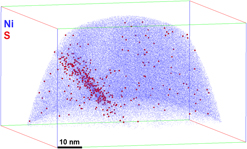Crossref Citations
This article has been cited by the following publications. This list is generated based on data provided by
Crossref.
Rathmann, Dominic
Pratama, Killang
Bachmaier, Andrea
Marx, Michael
and
Motz, Christian
2019.
Proceedings of the First International Conference on Theoretical, Applied and Experimental Mechanics.
Vol. 5,
Issue. ,
p.
345.
Krauß, Sebastian
Schieß, Thomas
Göken, Mathias
and
Merle, Benoit
2020.
Revealing the local fatigue behavior of bimodal copper laminates by micropillar fatigue tests.
Materials Science and Engineering: A,
Vol. 788,
Issue. ,
p.
139502.
Pratama, Killang
and
Motz, Christian
2020.
Strategies to Achieve High Strength and Ductility of Pulsed Electrodeposited Nanocrystalline Co-Cu by Tuning the Deposition Parameters.
Molecules,
Vol. 25,
Issue. 21,
p.
5194.
Cavaliere, Pasquale
2021.
Fatigue and Fracture of Nanostructured Materials.
p.
155.
Cavaliere, Pasquale
2021.
Fatigue and Fracture of Nanostructured Materials.
p.
1.
Jankowski, Alan F.
2021.
Selective determination of grain size in the electrodeposition of nanocrystalline nickel foils.
Materials Science and Engineering: B,
Vol. 263,
Issue. ,
p.
114876.
Luksch, Jutta
Lambai, Aloshious
Mohanty, Gaurav
Schaefer, Florian
and
Motz, Christian
2023.
Bridging macro to micro-scale fatigue crack growth by advanced fracture mechanical testing on the meso-scale.
Materials Science and Engineering: A,
Vol. 884,
Issue. ,
p.
145452.
Mladenović, I. O.
Vuksanović, M. M.
Jovanov, V.
Radovanović, Ž.
Obradov, M.
Nikolić, N. D.
and
Vasiljević-Radović, D. G.
2023.
Metal Matrix Composite Coatings Based on Ni Matrix and Biosilica Filers Obtained from Rice Husks.
p.
1.
Pillmeier, Simon
Burtscher, Michael
Laplanche, Guillaume
Pippan, Reinhard
Eckert, Jürgen
and
Hohenwarter, Anton
2024.
On the fatigue crack growth behavior of nanocrystalline CrMnFeCoNi.
International Journal of Fatigue,
Vol. 188,
Issue. ,
p.
108530.
Hohenwarter, Anton
Leitner, Thomas
and
Pippan, Reinhard
2024.
Fatigue Crack Propagation Across the Multiple Length Scales of Technically Relevant Metallic Materials.
Annual Review of Materials Research
,
Vol. 54,
Issue. 1,
p.
223.
Luksch, Jutta
Niegisch, Johannes
Jordt, Maike
Weissenberger, Marion
Pauly, Christoph
Schaefer, Florian
and
Motz, Christian
2025.
Tailored Nickel Base Multilayer Systems with Adjusted Grain Size and Chemical Composition.
Advanced Engineering Materials,
Vol. 27,
Issue. 7,
